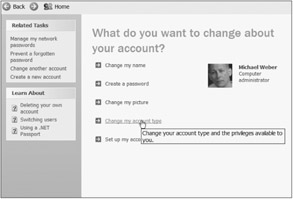The Administrator Account
If you create additional user accounts after you install Windows XP, they'll be set up as administrator accounts with no passwords by default. When you set up multiple user accounts on one machine, any user with administrator access can view the documents in another user 's My Documents folder, for example. If you're the computer administrator, here's how to plug this security hole.
-
Click User Accounts in the Category View Control Panel. If you favor the Classic View Control Panel, double-click.
-
Click Change an Account.
-
Click the user account that you want to modify.
-
Click Change the Account Type.
-
Select the desired account type for this user account.
-
Click the Change Account Type button.
-
To assign a password to this account, click Create a Password.

Figure 12.2: UserAccount Controls
Granting Other User Accounts Limited Access
To ensure the utmost security and privacy, if you're the computer administrator, grant limited status to other accounts and restrict user access by assigning each user an individual password.
If you have Windows XP formatted as NTFS, the native file format of Windows XP, NT, and 2000, you can also hide files and folders.
To protect a folder
-
Right-click the folder.
-
Select Properties.
-
Click the Sharing tab.
-
Select Make This Folder Private.
Windows XP will prompt you to create a password or risk subjecting your private information to public scrutiny. No one, not even fellow system administrators, can access the files once you make the folder private. Every file or folder contained within the folders you choose to make private will take on the settings of the parent folder.

Figure 12.3: Folder Properties privacy feature
Creating a Dummy Administrator Account for Troubleshooting
Here's a tip I heard from Leo Laporte on TechTV's The Screen Savers.
Create an extra administrator account that you don't use on your Windows XP or Mac OS X machine. This dummy account will come in handy if you ever have trouble with your main account. If you can log in to your dummy account but not your main account, the problem is with the user-specific settings of your main account.
To create a dummy administrator account in Windows XP
-
Click User Accounts in the Control Panel.
-
Select Create a New Account.
-
Follow the steps in the wizard.
-
Select the Computer Administrator option and assign the account your normal password.
To create a dummy administrator account in Mac OS X
-
Open the Accounts System Preferences pane.
-
Click the New User button.
-
Assign the user the same password as your day-to-day account and enable administrator privileges for the new account.
Passwords
If your computer is sitting alone at home, chances are you don't need a password. If others have access to your PC or if it's mobile, you not only require a password, you also need a definitive password strategy. The object is to make it as difficult as possible for a cracker to guess your password. This leaves the cracker no alternative but to mount a brute-force search, trying every possible combination of letters , numbers , and punctuation. A search of this sort ”even conducted on a machine that can compute one million passwords per second (most machines can compute less than one hundred per second) ”would require more than a hundred years to complete.
Password don'ts:
-
Don't use your login name in any form.
-
Don't use your first or last name in any form.
-
Don't use your spouse's, pet's, or child's name.
-
Don't use license plate numbers, telephone numbers, social security numbers, the brand of your automobile, your street address, and so on.
-
Don't use a password comprised of all digits or of all the same letter.
-
Don't use words contained in English or foreign language dictionaries, spelling lists, and so on.
-
Don't use a password that has fewer than six characters .
Password dos:
-
Do use a password that will be easy to remember and that you don't have to write down.
-
Do use a password with mixed-case alphabetic characters (uPAnDdOwN).
-
Do use a password with non-alphabetic characters such as digits and punctuation (!q@W3#edc).
-
Do use a password you can type quickly, without having to look at the keyboard. This will make it more difficult for someone to steal your password by spying .
How to choose a password that's easy to remember:
-
Use the memorized street address of a distant friend or relative (7925mAiN).
-
Choose a line from a song and use the first letter of each word. "He's a real nowhere man sitting in his nowhere land" becomes HarNmsiHN1, but it's easy to remember.
-
Use two short words and concatenate them with a punctuation character in between, like the password on an AOL CD (dOg;raIn, Book+muG, kiD?Goat, and so on).
-
Use your imagination . A good password pays dividends every time you use it, so creating one should be fun!
EAN: 2147483647
Pages: 135